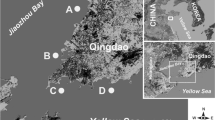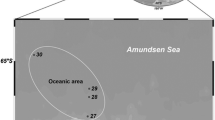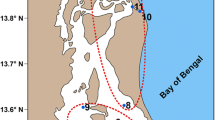Abstract
Introduction
Ciliated protozoa play important roles in aquatic ecosystems especially regarding their functions in micro-food web and have many advantages in environmental assessment compared with most other eukaryotic organisms. The aims of this study were focused on analyzing the application of an indicator based on taxonomic relatedness of ciliated protozoan assemblages for marine environmental assessment.
Materials and methods
The spatial taxonomic patterns and diversity measures in response to physical–chemical variables were studied based on data from samples collected during 1-year cycle in the semi-enclosed Jiaozhou Bay, northern China.
Results
The spatial patterns of ciliate communities were significantly correlated with the changes of environmental status. The taxonomic distinctness (Δ*) and the average taxonomic distinctness (Δ+) were significantly negatively correlated with the changes of nutrients (e.g., nitrate nitrogen and soluble active phosphate; P < 0.05). Pairwise indices of Δ+ and the variation in taxonomic distinctness (Λ+) showed a decreasing trend of departure from the expected taxonomic breadth in response to the eutrophication stress and anthropogenic impact.
Conclusion
The taxonomic relatedness (especially the pairwise Δ+ and Λ+) indices of ciliate communities are robust as an indicator with scientifically operational value in marine environmental assessment.





Similar content being viewed by others
References
Clarke KR, Gorley RN (2006) User manual/turorial. PRIMER-E Ltd, Plymouth
Clarke KR, Warwick RM (1998) A taxonomic distinctness index and its statistical properties. J Appl Ecol 35:523–531
Coppellotti O, Matarazzo P (2000) Ciliate colonization of artificial substrates in the Lagoon of Venice. J Mar Biol Assoc UK 80:419–427
Finlay BJ, Esteban GF (1998) Freshwater protozoa: biodiversity and ecological function. Biol Conserv 7:1163–1186
Gong J, Song W, Warren A (2005) Periphytic ciliate colonization: annual cycle and responses to environmental conditions. Aquat Microb Ecol 39:159–170
Ismael AA, Dorgham MM (2003) Ecological indices as a tool for assessing pollution in El-Dekhaila Harbour (Alexandria, Egypt). Oceanologia 45:121–131
Jiang J, Wu S, Shen Y (2007) Effects of seasonal succession and water pollution on the protozoan community structure in an eutrophic lake. Chemosphere 66:523–532
Leonard DRP, Clarke KR, Somerfield PJ, Warwick RM (2006) The application of an indicator based on taxonomic distinctness for UK marine biodiversity assessment. J Environ Manage 78:52–62
Liu D, Sun J, Zhang J, Liu G (2008) Response of the diatom flora in Jiaozhou Bay, China to environmental changes during the last century. Mar Micropaleontol 66:279–290
Lynn DH (2008) The ciliated protozoa. Characterization, classification and guide to the literature, 3rd edn. Springer, New York
Montagnes DJS, Humphrey E (1998) A decription of occurrence and morphology of a new species of red-water forming Strombidium (Spirotrichea, Oligotrichia). J Eukaryot Microbiol 45:502–506
Mouillot D, Gaillard S, Aliaume C, Verlaque M, Belsher T (2005) Ability of taxonomic diversity indices to discriminate coastal lagoon environment based on macrophyte communities. Ecol Indic 5:1–17
Prato S, Morgana JG, La Valle P, Finoia MG, Lattanzi L (2009) Application of biotic and taxonomic distinctness indices in assessing the ecological quality status of two coastal lakes: Gaprolace and Foglino Lakes (Central Italy). Ecol Indic 9:568–583
Somerfield PJ, Clarke KR, Warwick RM, Dulvy NK (2008) Average functional distinctness as a measure of the composition of assemblages. ICES J Mar Sci 65:1462–1468
Song W, Warren A, Hu X (2009) Free-living ciliates in the Bohai and Yellow Seas. Science Press, Beijing, In both Chinese and English
Tan X, Shi X, Liu G, Xu H, Nie P (2010) An approach to analyzing taxonomic patterns of protozoan communities for monitoring water quality in Songhua River, northeast China. Hydrobiologia 638:193–201
Warwick RM, Clarke KR (1995) New “biodiversity” measures reveal a decrease in taxonomic distinctness with increasing stress. Mar Ecol Prog Ser 129:301–305
Warwick RM, Clarke KR (2001) Practical measures of marine biodiversity based on relatedness. Oceanogr Mar Biol 39:207–231
Xu H, Min GS, Choi JK, Jung JH, Park MH (2009) An approach to analyses of periphytic ciliate colonization for monitoring water quality using a modified artificial substrate in Korean coastal waters. Mar Pollut Bull 58:278–1285
Xu H, Song W, Warren A, Al-Rasheid KAS, Al-Farraj SA, Gong J, Hu X (2008) Planktonic protist communities in a semi-enclosed mariculture pond: structural varation and correlation with environmental conditions. J Mar Biol Assoc UK 88:1353–1362
Xu K, Choi JK, Yang EJ, Lee KC, Lei Y (2002) Biomonitoring of coastal pollution status using protozoan communities with a modified PFU method. Mar Pollut Bull 44:877–886
Acknowledgments
This work was supported by the National Natural Science Foundation of China (No. 40976075, 30700069), and a grant from the Center of Excellence in Biodiversity, King Saud University. Special thanks are due to Mr. X. Fan, Ms. J. Jiang and X. Chen, Laboratory of Protozoology, Institute of Evolution and Marine Biodiversity, Ocean University of China, China, for their help with sampling and sample processing.
Author information
Authors and Affiliations
Corresponding author
Additional information
Responsible editor: Thomas Braunbeck
Rights and permissions
About this article
Cite this article
Xu, H., Jiang, Y., Al-Rasheid, K.A.S. et al. Application of an indicator based on taxonomic relatedness of ciliated protozoan assemblages for marine environmental assessment. Environ Sci Pollut Res 18, 1213–1221 (2011). https://doi.org/10.1007/s11356-011-0476-6
Received:
Accepted:
Published:
Issue Date:
DOI: https://doi.org/10.1007/s11356-011-0476-6




